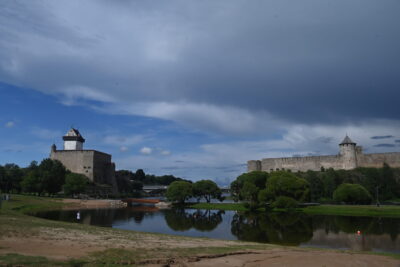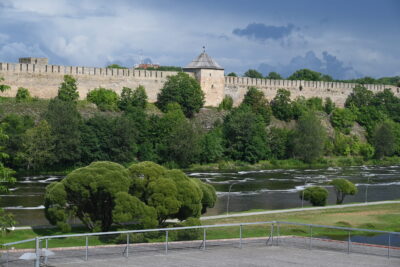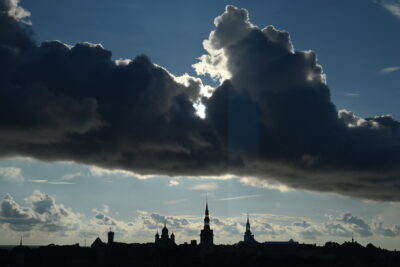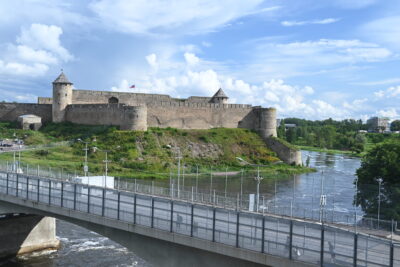by Bill Murray
 It’s raining in Russia. Thunderheads boil up in the afternoon heat over there, behind the limestone block fortress on the other side of the river. Which is not a wide river. You can shout across it.
It’s raining in Russia. Thunderheads boil up in the afternoon heat over there, behind the limestone block fortress on the other side of the river. Which is not a wide river. You can shout across it.
Here’s how close Russia is: on Victory Day, May ninth, commemorating the Nazi defeat in World War II, Russia points big screen TVs over here toward Narva, Estonia’s easternmost city, to explain the way things really are to all these misguided Estonians.
This year Estonia put on their own concert on the town hall square. This side of the Narva River, May ninth is called Europe Day. Estonia hung a poster on its own castle wall that read “Putin is a war criminal.”
Both riverbanks are park land, well kept, landscaped, trees trimmed as if by respectful neighbors. These dueling castles mark the spot where the Teutonic Order, Swedes, Danes, Poles, Lithuanians, Slavs and local Finno-Ugrics have bumped up against each other since medieval times. This point on the map has been the tip of somebody’s sword since the 13th century.
Everybody in the train spoke Russian, Russians and Estonians both. For the confluence of Vladimir Putin’s “greatest geopolitical catastrophe of the century” with Estonia’s triumph of independence, it’s far more Russophilic out here than I expected.
Thirty-three years after Estonian independence, that’s something to puzzle out. Part of the explanation, I think, is cultural. The other part is that it just takes time to start a new country.
Mr. Putin’s “greatest catastrophe” was the Soviet Union’s collapse, which tore a gaping rift all the way around its twelve and a half thousand-odd mile periphery, comprising twelve new countries.* Each set out to find their own way, and most got lost in the taiga. Everything changed. For some, the very alphabet changed. Only five of the new states retained Cyrillic as their official state alphabet.**
The fighting today in Russia’s Kursk Oblast and in Ukraine’s east is ultimately fallout from the “greatest catastrophe.” That humiliation of a superpower, paired with this particular leader, disrupted local society everywhere – in every direction – in every way. So a visit to a border is clarifying. What it is, is, it’s complicated.
I think here, at least, Estonia suffered more societal disruption than Russia. If you live in Narva, your cousins across the river went right on being Russian, while your new sovereign rode into Tallinn, the national capital, untested and uncertain, and before long ceded some of its power, improbably, to Belgium (Note to Brussels: thanks for the newly paved roads, though).
Prosperity didn’t follow independence. Not in Tallinn, two hours back down the train line where independence crusaders most loudly demonstrated, and especially not out here on the border, where the new divorcées on either side of the river scrabbled for common assets under common rain clouds. As we’ll see, they can’t even agree on where the border is.
As in divorces among people, sometimes meanness lingered, both personal and institutional, and that was for a reason. As Anatol Lieven quoted a friend in his book The Baltic Revolution:
“The greatest mistake of the leaders of our independence movement was not to make a substantial appeal to the Russians in Estonia at the very beginning. The reason they did not do this is because they hate them.”
The charge against Russians across the Baltic states and beyond was that they were interlopers. They had utterly no attachment to the national identities of Lithuania, Latvia or Estonia. As Lieven wrote, “they are pure examples of Homo Sovieticus.”
 Yet with time, the bonfires of resentment burned less bright across the river and peoples’ grievances lost fervor until today, at the farthest reach of NATO’s and the EU’s supply lines, Narva presents, more than anything, as Sad Sack, left behind, a little forlorn, mostly concerned today about depopulation.
Yet with time, the bonfires of resentment burned less bright across the river and peoples’ grievances lost fervor until today, at the farthest reach of NATO’s and the EU’s supply lines, Narva presents, more than anything, as Sad Sack, left behind, a little forlorn, mostly concerned today about depopulation.
It’s not fraught on this border; it’s not on edge. People will tell you that’s because they’re worn out with politics, and they have every right to be. Still, it’s clear enough that things could turn tense with nothing more than an ill wind across the Narva River.
Narva residents know that if Russia were so determined, they would live in the next Donetsk or Luhansk. By the time NATO asked for clarification, Narva would be far behind any new front line.
The nearest military base housing NATO troops is more than sixty miles to the west, at the confluence of rail lines in Tapa, a former Soviet military base. Best I’ve learned, three of the eight barracks are meant for what NATO calls its Enhanced Forward Presence, and more are under construction.
Earlier this year Russian maritime police removed half the buoys marking the border in the river just downstream from the two castles. The European Union got angry, conspiracy theorists theorized, and the hair-trigger crowd charged it was part of a grand Russian plan to change its maritime borders with Finland and Lithuania as well. It looks like here in Narva people are more circumspect, or maybe they’re just more used to small bore thuggery, slower to rise to cheap Russian provocation.
Estonia is way up north, where rivers freeze. After the thaw last spring Estonia put down 50 buoys, and Russia removed 25 of them early in the morning ten days later.
We spent an afternoon with a Narva native named Denis Bjorkland who works for Narva Tourism, the city government and sometimes translates for the mayor. An agreeable, voluble man in his thirties, he is fluent in English, Estonian and Russian, and wears a pirate’s hat on his internet bio page.
Denis told us that before this year the authorities on both sides would survey the bottom of the river channel annually because it meanders, and agree on a new demarcation line every spring. This year, he said, Russia claimed the Estonians wouldn’t do the survey, and Russia says that’s why they hauled out the buoys.
Naturally, it’s not quite as simple as that.
“Actually, here we don’t have official border with Russia. Because the only agreement between Estonia and Russia was made in 1920.…
“That’s why something we have in the middle of the river, it’s not called the border, it’s called, demarcation of separation line. That’s why for taking away our buoys we cannot punish Russia because again we don’t have official border, it’s just demarcation line.”
He wouldn’t be further drawn on which side was right in the incident, but instead struck a conciliatory pose, and used the opportunity to commend the Estonian border police for their calm.
•
 It turns out declaring independence doesn’t immediately free the people and bestow prosperity. What it does is immediately yoke the new independence leader to a sentence of nation building at hard labor.
It turns out declaring independence doesn’t immediately free the people and bestow prosperity. What it does is immediately yoke the new independence leader to a sentence of nation building at hard labor.
The successful candidate shall be a philosopher, a polymath, a visionary, an educator, an economist and a leading light, besides excelling at every HR skill, including motivation, team building, talent acquisition, crisis management, public relations, risk mitigation, cultural sensitivity and fairness.
Everything must be done, for with independence comes every kind of challenge. The new leader needs time just to extend his or her writ past the capital city limits, never mind out to the borders. In the meantime, and every day, it’s chaos all the way down.
In Estonia Russian culture had to be undone, yet here in Narva, Russians were the majority. They were what military planners would call facts on the ground.
Denis, the city employee, said “This year is the first year most of population of Narva is Estonian citizens.… Before that we had more Russian citizens or persons without citizenship than Estonian citizens.”
He refers to holders of “gray passports” – travel documents issued to residents of Estonia who are neither Estonian citizens nor citizens of any other country. Officially “Alien’s passports,” they’re called gray passports not just to reflect the scant opportunity they afford – gray is also their color.
They were introduced after independence, primarily for former Soviet citizens living in Estonia who did not qualify for automatic Estonian citizenship. They were to serve as travel documents and proof of identity and residency. When Estonia regained independence, citizenship was only automatic for Estonian citizens before Soviet occupation (in 1940) and their descendants.
Russians who arrived during the Soviet period were (and still are) required to go through naturalization, which involves passing an Estonian language test and a test on the Estonian Constitution and Citizenship Act. Some, naturally, found this onerous and/or political harassment.
•
The execution of Russia’s war on Ukraine has made plain that individual initiative is not one of Moscow’s priorities. The sixty kilometer tank queue from Belarus that halted in place awaiting orders in the first days of the war is the cardinal example. Top down thinking apparently sinks in after a few authoritarian generations.
The education system in a new country like Estonia would be keen to reorient students away from all that. And it would want to emphasize Estonian history, culture, literature, and promote democratic values.
New textbooks would need to be written. Teachers would have to be retrained. Civics study, and electives like information technology would have to be newly introduced. (Estonia’s digital transformation has been wildly successful, with IT amounting now to some seven and a half percent of GDP.) A new country would need to be created in Estonian minds as well as across the land.
But the Estonian parliament declared independence on the night of 20 August, 1991, and you can be a full grown Estonian adult in 2024 and still be a native Russian speaker. How can that be?
It’s because change had to be gradual, not just due to sensitivity to the sizable Russian minority, but also for more practical reasons – like where to find qualified teachers.
At independence, the free state of Estonia was more than a full third ethnic Russian, state schools taught in Russian and everybody spoke it. After two years of deliberation the Law on Basic and Upper Secondary Schools declared a deliberately gradual rollout: Estonian would become the language of instruction in all state-run secondary schools by 2000.
The upshot is that thirty year old Estonians who have no memories of the Soviet period may still speak Russian today as their native tongue.
There’s also this, undeniably true, from Denis Bjorkland: “culturally Russian is just much bigger than Estonian because of literature, for example. In Russian language you can read every author in the world maybe, in Estonian there are translated only a few.”
And something else. Narva, a small town out along the border, has no local television. TV is all broadcast from the center, with a mix of Estonian and Russian programming, no doubt curated with much thought by the Ministry of Culture. Except if you’re close enough to Russia to share a rain cloud, you are close enough to watch Russian broadcast TV.
“Russia launches one of war’s biggest drone attacks on Ukraine,” CNN charges on one channel, and — click — a dance troupe high steps on a Russian variety show on the next. It’s utterly dissonant and very strange.
•

One of the most thoughtful writers about Russia’s war on Ukraine is the historian Timothy Snyder, who differentiates between ‘liberation’ and ‘de-occupation.’ Estonia has surely been liberated in fact. It is free, and its prosperous capital is testimony to thirty years of economic progress.
There may be a small way though, in the minds of eastern Estonians, in which they are yet to be de-occupied.
About those young adults who don’t remember the Soviet era: it’s worthwhile to consider what they do remember. For them, freedom and independence brought in the lawless 90s. Here are Denis’s earliest memories:
“1990s, it was the time when on our market came heroin … and it was actually dangerous to live here because those drug addicts, they needed money to buy the drug and … they were just walking around the town robbing the children. Especially popular were the first days of month … because it was the moment when schools were collecting the money for food. … The parents gave them money and were sending them to schools … and those robbers … they were actively robbing all around especially in the morning like eight o’clock, nine o’clock while the children were moving with their money to the schools.”
Schoolboys terrorized by heroin addicts for their lunch money. It’s not the way we remember the West’s great triumph over Communism.

Have a look at the people over in Russia at Ivangorod castle’s ramparts, looking back at you. Many are probably tourists from St Petersburg, ninety-five miles up the road.
Before February 2022 St Petersburg was where to go from Narva for shopping, culture, for everything big city. It’s not just bigger than Narva, it’s more than four times the population of all of Estonia.
Those people over there, they’re probably there for the same proximity-to-peril titillation we’re here for. But unlike us, or any EU citizen who might blunder in from Lisbon, say, or Ljubljana or Limassol, they will have needed specific, prior permission. The mechanism to enforce this is Russia’s declaration of Ivangorod as a ‘border control zone,’ which proscribes movement, photography and so on.
The bridge over the river has been closed to vehicles while Russia builds a new border station. It is open for foot traffic daily from 7:00 to 23:00.
Not long ago a hapless group spent the night out on the bridge. They’d left the Estonian border before 23:00, the Russians closed their side while they were in neutral territory, and the Estonian side closed before they got back.
 Informal comaraderie had prevailed among the border guards before that night, with (as the Estonians tell the tale) either side staying a little late as necessary. That border cooperation is gone.
Informal comaraderie had prevailed among the border guards before that night, with (as the Estonians tell the tale) either side staying a little late as necessary. That border cooperation is gone.
Denis says “if you want to cross the border it will take seven to nine hours” in the queue. The pedestrian queue doesn’t stretch back halfway across the bridge today, but, Denis says, of course that’s not all of it, the queue extends another fifty meters or so through a tunnel at the end of the bridge. And “it is extremely hot in the tunnel.”
•
Rising on a plinth opposite the bridge are three flags. Elsewhere in the city you’ll find an arrangement like this displaying flags of the European Union, Estonia and Narva. Here, pointedly, fly the flags of the EU, Estonia and NATO. They stand on the riverfront facing the Russian tricolor over Ivangorod’s rival castle.
Last June the West marked the 80th anniversary of the Normandy invasion and commemorated the defeat of the Nazis. Estonian kids grow up learning about German tyranny, too, but they learn about different good guys.
Vaivara, not twenty miles from Narva, housed the largest Nazi concentration camp in Estonia. Victory Day in Vaivara, like the West’s D-Day ceremonies in Normandy, honors surviving soldiers, especially Estonian soldiers. Who fought alongside Russians in the Soviet army.
A ‘war museum on wheels,’ housed in a shipping container, stopped in Narva in June and July. It displayed uniforms, weapons and equipment from World War II, and celebrated Russia’s role as savior.
That mirrored an exhibit I saw on the Great National Assembly Square in Moldova’s capital, Chişinâu, this summer, also in a shipping container of sorts – an old rail car, like the ones with which Moldovans were deported into the Gulag. By Russians.
It’s complicated.
•
*Armenia, Azerbaijan, Belarus, Georgia, Estonia, Latvia, Lithuania, Kazakhstan, Moldova, Turkmenistan, Ukraine and Uzbekistan
** Belarus, Kazakhstan, Kyrgyzstan, Russia and Tajikistan
If stories about the former Soviet rimland are your cup of tea, my last column from Moldova, might be, too.
Enjoying the content on 3QD? Help keep us going by donating now.
